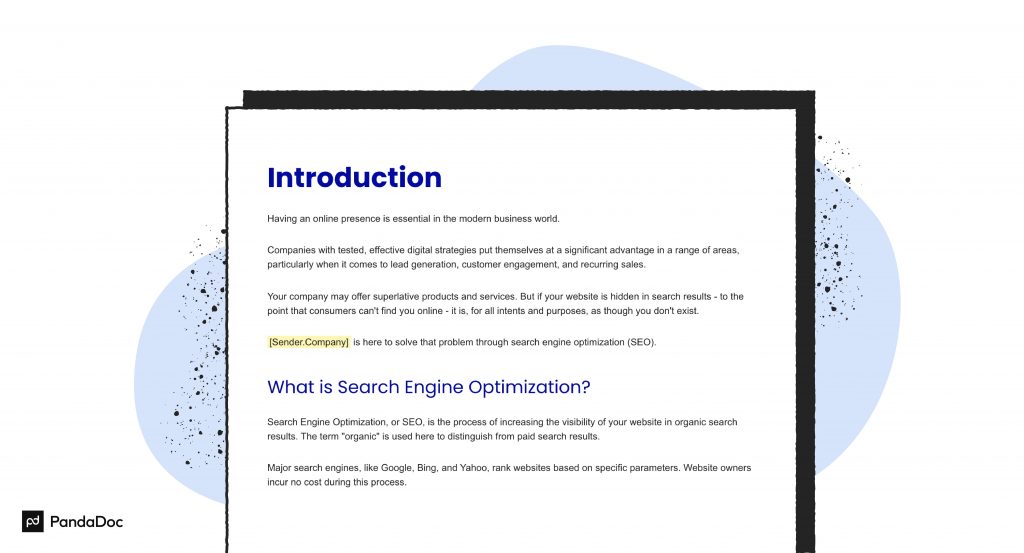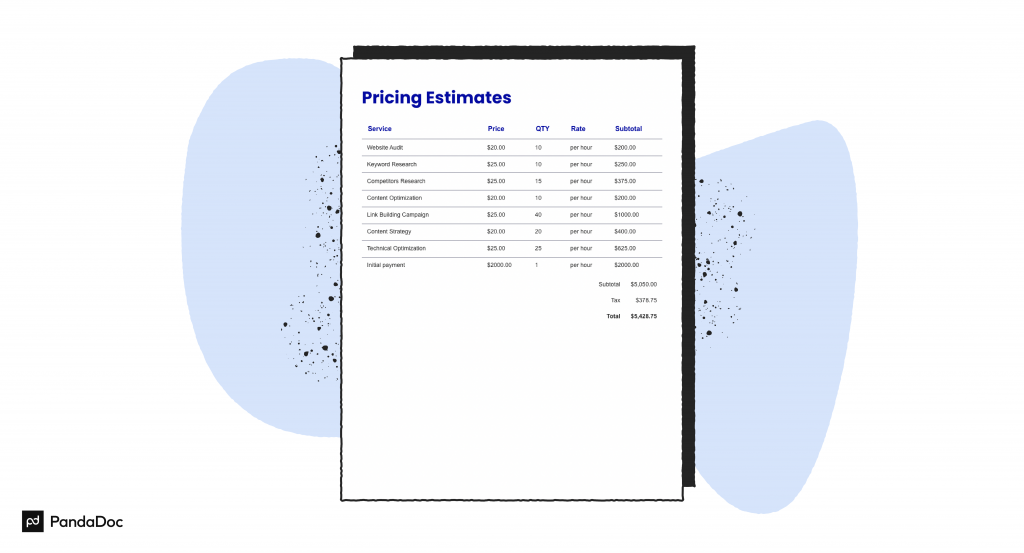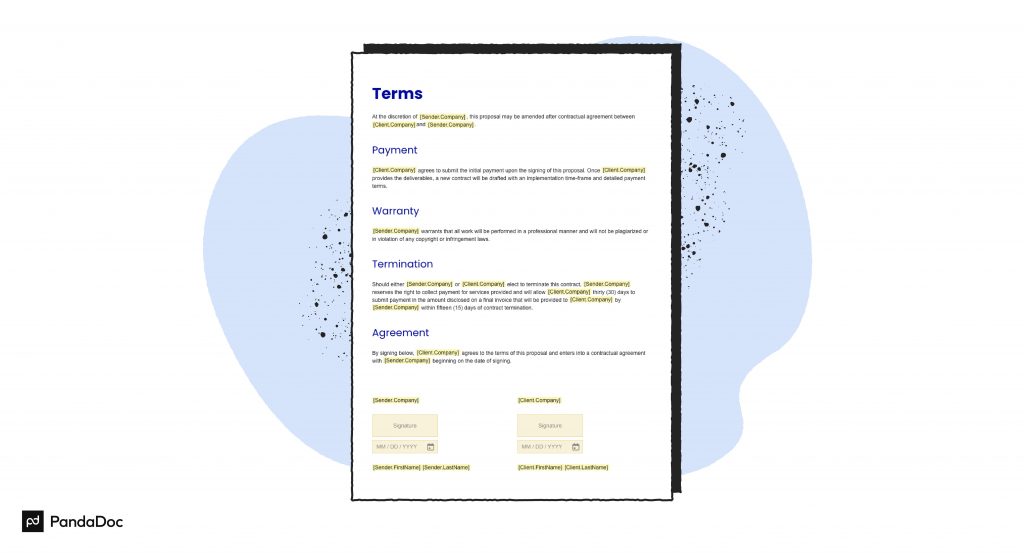If you offer SEO services as an agency or a consultant, then your SEO proposal is the first step in securing new clients. An SEO proposal is an opportunity to capture the client’s attention and put you ahead of the competition.
Your target customers will contact multiple SEO agencies searching for the best service, but a compelling and actionable proposal will enable you to stand out in the crowd.
A lot of digital marketing agencies will fill their proposals with buzz words and technical terms as proof of expertise. However, this marketing strategy often has the opposite effect and confuses the prospective client.
Instead, you need to focus on writing an easy-to-understand proposal with measurable goals that the client can relate to. This is your first step towards creating a winning SEO proposal.
I will walk you through the seven key elements of writing an SEO proposal to make client acquisition easier for a freelancer like you.
By following this proposal process, you get a better idea of your client’s needs, which allows you to create a proposal that exceeds their expectations.
Step 1. Discover what the client wants
Before you write your SEO proposal, you need to anticipate what a typical client will need.
Asking your leads a set of questions will help you discover what they expect to get out of your SEO services and how they intend to achieve those results.
Most SEO questionnaires have four main questions:
1. What are your expectations from SEO?
Website owners need SEO for many reasons, the foremost of which is to go up the search rankings. However, this goal is often just a means to an end. Your potential clients could have the following reasons for seeking SEO services:
- Higher organic traffic
- More phone or email inquiries
- More leads
- Higher sales and conversion rates
- Higher ROI
Some clients will talk about vanity metrics like boosting organic traffic without even knowing what impact it will have on their website.
In such cases, your proposal should convert these metrics into actionable and measurable content strategy goals. This helps educate your clients about technical SEO and establishes your credibility as a service provider. You can even make use of free seo tools available.
2. Who are your target customers, and what are their major pain points?
Each business has its target market that depends on the product or service they’re selling. Your role in SEO work is to know your client’s target audiences and their pain points.
For example, if your client operates a web hosting service business, you need to know who they’re trying to market to.
Do they aim for ecommerce businesses, bloggers, or a more general audience? If their client base is mostly ecommerce businesses, what makes businesses choose one hosting service over others?
Knowing a potential client’s target audience and their concerns will play a key role in putting together an SEO plan that provides value.
Your proposal could include content targeted towards ecommerce, which could include tips for increasing revenue or promoting products.
3. Who are your top competitors?
Your clients will probably have a list of sites that they consider their biggest competitors in the industry.
These don’t have to be the biggest names in the niche – in fact, you’ll probably get some lesser-known names in their reply. Your potential clients consider them competitors because they offer similar services or operate in the same area.
Creating a list of competitors will help you determine what sets them apart from the client and what your client has to do to catch up or surpass them.
For example, if a competitor is more popular in a specific market demographic, you need to create an SEO strategy that improves your client’s performance in that segment.
4. What are the keywords your audience uses while searching for your business?
Once you get your clients’ top-ranking keywords, do a quick search to identify the keywords used by their competition. This will highlight gaps that you can highlight in your proposal and the steps you’ll take to start ranking for those keywords.
Step 2. Create a compelling summary of your actions
When you write an SEO proposal, you don’t have to start from scratch all the time. Instead, you can use a template that covers the main features of your service then customize your proposal to meet the client’s needs.
PandaDoc has an excellent SEO proposal template that serves as an introduction to your SEO practice and a rundown of the services you can offer.
Let’s run through a few sections of the template and discuss what they’ll do for you and your client:
1. Start with the needs/problems/objectives
Any good SEO proposal template begins by narrating your client’s business objectives and pain points and how you plan to address them. You may write the summary to convince the client that you understand what they need and how you can fill those needs.

In the example above, the introduction addresses the client’s most pressing need, which is driving qualified traffic to their site. This headline isn’t just a description.
It’s an expression of intent. Anyone who reads the summary will know right away what the SEO agency wants to do.
2. Highlight achievable business goals
After writing a powerful headline, convert the broad business objectives into measurable goals that they would achieve by using your service.
For instance, you can use the heading “Accelerated mobile performance and mobile optimization”, then discuss what exactly “accelerated” means in this context.
You need to put in a reasonable estimate of your expected results, such as “3 seconds faster-landing page loading time”.
3. Define your work strategies
Explain in brief the strategies you would implement to meet your potential client’s objectives. If they aim to boost organic traffic to their online store, describe what you would do to help them attain their objectives.
Clearly define your strategies in 2 to 3 lines. You can mention SEO tactics such as SEO audit, on-page SEO, content development, internal/external linking, email outreach, meta tags, and so on.
It’s a good idea here to also help them understand how your strategies, combined with their own, will impact their bottom line.
For example, explain to them that if you’re able to increase their leads coming into the business, they can then use email marketing software to automate the follow-up and potentially land new clients.
While some companies have the staff in place to fully understand how a marketing plan comes together, it never hurts to elaborate on ideas to help them connect the dots.
Step 3. Clearly define your deliverables
Your client is looking for technical SEO experts to solve their key pain points. You cannot solve those problems in just one sitting.
Instead, you do it through a sequence of activities. Your SEO proposal should include a list of deliverables that defines what your clients can expect from you.
You might be tempted to mention the different types of SEO services that you offer, such as link building or social media community management.
However, your potential clients may only need a specific set of services. Your proposals should include only what your clients need and define them in terms of things that you could deliver.
Here are some things you can do for your clients as part of your SEO packages:
- Primary audits: This may include keyword audit, site audit, content audit, and link audit – all activities designed to see whether your online presence is healthy or counterproductive.
- Keyword research: This category includes keyword research using Google Keyword Planner. By identifying a mix of short- and long-tail keywords to rank for, you expose your clients to different kinds of online searches, resulting in higher search volumes.
- Competitor analysis: Knowing your competitors goes beyond identifying their market share and product line. A full-fledged SEO campaign also involves knowing your competitors’ target keywords and identifying the websites that link back to them.
- Content writing: Using the insights you gain from the first three items in this list, you can start mobilizing your writers to produce informative, readable content for blogs and other internal pages. You may also create guest posts that will link back to your site (see below).
- Link building: Not all backlinks are good for your search engine rank. Backlinks from reputable sites help your clients’ sites rank better in SERPs, while paid backlinks from suspicious sources might lead to search engines penalizing your clients.
- SEO reporting: Describe how frequently your team sends out SEO reports and if those would be reviewed simultaneously in a regular site or online meetings.
Your SEO proposal template will probably cover one or more of the items listed above. However, before clients accept your offer, they will need convincing proof that you can deliver on your promises. This leads us to the next section.
Step 4. Show, don’t tell with testimonials
Your services might be impressive on paper, but potential clients aren’t likely to hire your SEO agency unless you can show proof that your methods work.
More often than not, they will ask you for customer references who can vouch for the quality of the work you do.
Your SEO proposal should include a short section for customer testimonials.
A typical testimonial section should include the following:
- A list of your clients. You don’t have to list everyone you’ve worked for. Instead, just include your biggest clients or the projects that resulted in the largest organic search ranking changes.
- A short description of the previous clients’ needs and your solution to fulfill these needs.
- An overview of SEO solutions that you customize for every client based on their unique needs.
- The end outcome of your customized SEO services
- Clients’ testimonials that mention how they have acquired more leads, sales, and ROI with your all-inclusive SEO services.
Step 5. Outline the timeline
No matter how well-planned or effective your methods are, technical SEO doesn’t yield lasting results overnight. Your clients might need to wait for a few weeks or months to see incremental improvements.
This is where a realistic timeline will come in handy.
Your SEO proposal template project timeline should differentiate between one-off tasks such as creating Google Analytics or Keyword Planner accounts and periodic tasks such as content writing, keyword research, and link building.
It should also contain the expected results for each task to serve as baselines.
For example, you can begin your website audit at the beginning of the project or before starting formally. You also need to do SEO reporting before, during, and after the project to measure your progress.
The timeline should contain the start, end, and duration of content creation for each keyword or guest post.
Creating and presenting a realistic timeline will not just help your clients understand what you’ll do on any given day.
It will also give you space to lay out your strategy, do as much research as needed, and deliver the content your clients need on time.
Step 6. Make a compelling offer
Your SEO proposal template should wrap up nicely with a compelling offer for your potential client. While some SEO practitioners refer to the expenses as an “investment” or “engagement fee”, we prefer the term “pricing”.
A good pricing sheet will enumerate the deliverables you’ve promised and the cost for each. This will allow your clients to mix and match the services they’ll get from you according to their budget.

You may also offer pre-packaged deals that cover different customer needs and budgets.
For example, you can offer a combination of copywriting and keyword research for a lot less than a full-blown search engine optimization campaign that involves a total overhaul of your copywriting team.
Give your prospects a variety of pricing options to select from. By offering your prospects control over the buying process, they tend to opt for your services.
Your standard package will constitute all the types of SEO services you mentioned in your proposal.
Give your clients two or three other options to choose from – a simple package with no extra features, a deluxe package that includes a few extra services, and a less expensive package that your clients can easily afford.
Step 7. Ensure all legal formalities are included
Conflict is unavoidable whenever you don’t know your clients very well.
However, your proposal will ensure that everything is above board. To build credibility with your clients, don’t forget to add legal formalities to your SEO proposal to prevent conflict down the line.
For example, a “Terms and Conditions” section to your SEO proposal will not protect the client in case you don’t provide the service that you promised; it will also protect you if the client refuses to pay for what you do.
The laid-out terms and conditions won’t give your clients a chance to back out of the settlement. As a result, you can be confident that you would get paid for the service you provide to your clients.

Remember, your potential clients are not SEO experts.
Your proposal content should be as clear and easily understandable as possible. Writing in a professional and straightforward tone will make even the most technical concepts accessible.
When in doubt, think about how you would describe something to clients personally if they get stuck with anything.
This includes not just the list of deliverables or the methods you’ll use but also the terms and conditions of your proposal. A client is more likely to sign a simple and easily comprehensible proposal than a more complicated one.
There are three things you need to do to get sign-off on your SEO proposal:
- Get the client to sign the proposal digitally using an e-signature.
- Ensure that you’ve received the first installment of the invoice payment, depending on what you’ve specified in your proposal’s “investment” or “payment” section.
- Arrange a call to discuss the next steps in your engagement with your customer.
Your terms and conditions sections should cover all legal issues that may crop up down the line. It is best to get legal advice while drafting this section.
Your client will probably do the same as they review your proposal before deciding to sign or reject it.
In closing
Your SEO proposal is vital in converting a prospective client to a customer. You can impress and win over your target clients with a personalized, detailed, and well-drafted proposal.
To improve your proposal writing, focus on potential client’s pain points and central issues, build trust, and communicate how you can help.
Let’s recap the tactics to create winning SEO proposals for your clients:
- Discover what the client wants
- Create a compelling summary of your actions
- Clearly define what you can deliver
- Show, don’t tell with testimonials
- Outline the timeline
- Make a compelling offer
- Ensure all legal formalities are included
Good luck with crafting your winning SEO proposal in 2021!
Looking For Document Management System?
Call Pursho @ 0731-6725516
Check PURSHO WRYTES Automatic Content Generator
https://wrytes.purshology.com/home
Telegram Group One Must Follow :
For Startups: https://t.me/daily_business_reads





